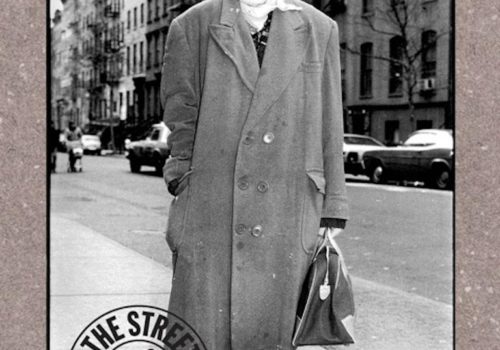“Arbus’s style is so casual it feels effortless, and every picture has wit, soul, and graphic snap. Roaming the East and West Village streets, she found and recorded many of the era’s most idiosyncratic icons, including….Madonna, whose stained camel-hair coat and scarily prescient bowling bag still look like the very definition of downtown chic. Arbus clearly understands the power of clothes to express personality, so the best of her work is a seamless blend of fashion and portraiture.” –Vince Aletti for The Village Voice
Photographer Amy Arbus will be showing her vintage black-and-white prints from “On The Street: 1980-1990” at New York’s Leica Gallery, opening February 28th. During the 1980s, Arbus had a monthly page in the Village Voice Style section, taking portraits of New York’s legendary “downtown” scene. Since that time, her photographs have appeared in The New Yorker, Vanity Fair, Rolling Stone, Architectural Digest and The New York Times Magazine, among other places; she has had twenty-five solo exhibitions worldwide; she teaches portraiture at the International Center of Photography and the Fine Arts Work Center; and she has published five photography books.
I spoke with Amy about her upcoming exhibition:
Elizabeth Avedon: How many photographs are there in your Leica Gallery exhibition?
Amy Arbus: There will be 45 prints on exhibit at the Leica Gallery from February 28 through April 19, 2014. They are mostly vintage prints made at the time I was doing the style page called, “On the Street” for the Village Voice. Some photographs have never been seen before because they weren’t published in either the Voice or in the book, On the Street 1980-1990.
EA: Were they all taken for The Village Voice? How many years did you work at the Voice?
Amy Arbus: Over the course of ten years I made thousands of photographs for the Village Voice and roughly 500 were published.
EA: What was the best location to scout people, how did you go about finding them?
Amy Arbus: I spent about a week photographing each month for a page of photos. I went to several neighborhoods but the East and West Villages were the most promising places to find people who had invented their own style.
EA: Did you exhibit those photos?
Amy Arbus: I had an exhibition at The Mudd Club after working at The Voice for three years. Included in this exhibit are prints I made for that show: Ann Magnuson, Anna Sui, Moroccan pants, Katy K & John Sex, and Joey Arias.
EA: Will your ‘celebrity’ portraits from that era be in this exhibition? Keith Haring, Sonic Youth….
Amy Arbus: Other luminaries from that time on exhibit will be: Madonna, The Clash, Phoebe Legere, Susanne Bartsch, The Rosenberg Twins, Messrs. McDermott & McGough and Grace Jones.
EA: Do you still observe people on the street as potential portraits?
Amy Arbus: I always see people on the street, at restaurants, parties or openings that I want to photograph. Lately I’ve been asking them to pose for a tintype portrait, which is a wet plate collodion process that was used during the Civil War. I think the photographs make one look like their own ancestor.
EA: Your vintage work appears to be in such contrast from your more recent series, “After Images,” an homage to classic painting masters such as Picasso, Modigliani, and Cezanne. Can you explain the bridge between them, if any?
Amy Arbus: My work has always been about style as an expression of personality, but each series is technically very different. In doing the work I find a photographic style which feels in keeping with the subject matter.
The “On the Street” series is very raw and rough edged, but deceptively organized. The prostitutes are literally and figuratively moving, romantic, poetic, and grainy. The nudists are intended to look like snapshots that are not composed.
The babies from my book, “The “Inconvenience of Being Born,” have all the elements of the last three, but the subjects and the photographs are even more wild and out of control.
“The Fourth Wall” was quite a departure. For that book, I took actors in character, in costume and make-up out of the context of their plays. The photographs are strong, deliberate and emotional. I scouted the locations and used portable studio lighting.
My last book, “After Images,” was produced with a crew which included two lighting technicians, a painter, a make-up artist, a stylist, hand-painted backdrops and many actors, models and dancers. The photographs are surreal in that they look like paintings except for the eyes which look very real.
The last two projects are my most photographically sophisticated work to date.
EA: At what age did you begin to seriously take up photography?
Amy Arbus: After studying flute and saxophone at Berklee College of Music in Boston for two years, I broke my two front teeth. It was a blessing in disguise because the minute I started photographing, I knew it was right for me.
EA: What did you imagine you would do before you became serious about photography?
I wanted to play bebop jazz music like Eric Dolphy and Charlie Parker.
EA: Who were your most influential photography mentors or teachers?
Amy Arbus: I studied with Larry Fink and Sylvia Plachy whose work I adore, but when I took a Master Class with Richard Avedon it changed my life. He gave me the license and the responsibility to become an artist and create something new to contribute to the medium. It is the gift that keeps on giving and the reason I am so committed to teaching.
EXHIBITION
Amy Arbus: On The Street 1980 – 1990
February 28 through April 19, 2014
Leica Gallery in New York
670 Broadway / Suite 500
New York, NY
USA
Artist reception February 27 from 6-8pm
http://www.amyarbus.com
http://us.leica-camera.com/culture/galleries/gallery_new_york/
http://elizabethavedon.blogspot.com
















